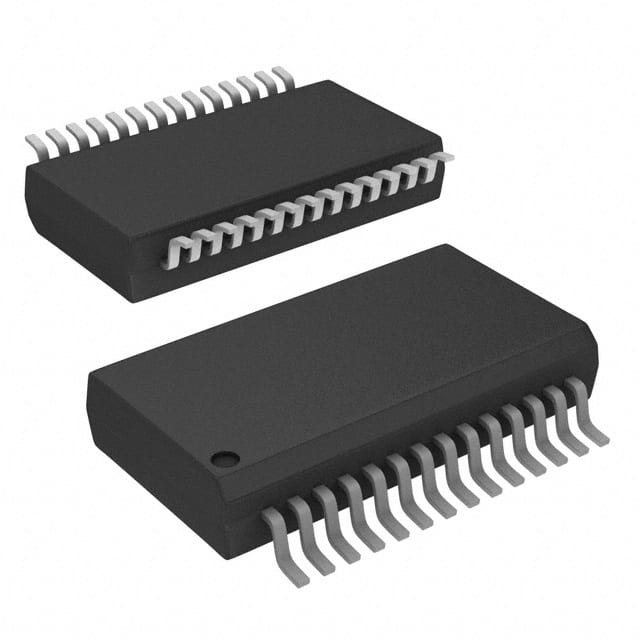PIC16C62A-10I/SS
Product Overview
Category
The PIC16C62A-10I/SS belongs to the category of microcontrollers.
Use
This microcontroller is commonly used in various electronic devices and embedded systems for controlling and processing data.
Characteristics
- High-performance 8-bit RISC architecture
- Low power consumption
- Wide operating voltage range
- Integrated flash memory for program storage
- Multiple I/O ports for versatile connectivity
- On-chip timers and counters for precise timing operations
Package
The PIC16C62A-10I/SS is available in a SSOP (Shrink Small Outline Package) package.
Essence
The essence of this microcontroller lies in its ability to provide efficient and reliable control and processing capabilities in a compact form factor.
Packaging/Quantity
The PIC16C62A-10I/SS is typically packaged in reels, with each reel containing a specific quantity of microcontrollers. The exact quantity may vary depending on the manufacturer's specifications.
Specifications
- Architecture: 8-bit RISC
- Operating Voltage Range: 2.0V to 5.5V
- Flash Memory: 3.5KB
- RAM: 128 bytes
- I/O Pins: 22
- Timers: 2
- ADC Channels: 5
- Communication Interfaces: SPI, USART, MSSP
Detailed Pin Configuration
The PIC16C62A-10I/SS has a total of 28 pins. The pin configuration is as follows:
- VDD - Power supply voltage
- RA0/AN0 - Analog input / Digital I/O
- RA1/AN1 - Analog input / Digital I/O
- RA2/AN2 - Analog input / Digital I/O
- RA3/AN3 - Analog input / Digital I/O
- RA4/T0CKI - Timer0 clock input / Digital I/O
- RA5/MCLR/VPP - Master Clear input / Programming voltage
- VSS - Ground
- RB0/INT - External interrupt input / Digital I/O
- RB1/SDI/SDA - SPI data input / I2C data input
- RB2/SDO/SA0 - SPI data output / I2C address bit 0
- RB3/SCK/SCL - SPI clock input / I2C clock input
- RB4/PGM - In-Circuit Serial Programming data
- RB5/PGC - In-Circuit Serial Programming clock
- RB6/PGD - In-Circuit Serial Programming data
- RB7/PGC - In-Circuit Serial Programming clock
- RC0/T1OSO/T1CKI - Timer1 oscillator output / Timer1 clock input
- RC1/T1OSI/CCP2 - Timer1 oscillator input / CCP2 module
- RC2/CCP1 - CCP1 module
- RC3/SCK/SCL - SPI clock input / I2C clock input
- RC4/SDO/SDA - SPI data output / I2C data output
- RC5/SDI/SA0 - SPI data input / I2C address bit 0
- RC6/TX/CK - USART transmit / Clock source
- RC7/RX/DT - USART receive / Data terminal
Functional Features
- High-speed processing capabilities
- Flexible I/O configuration for versatile connectivity options
- On-chip timers and counters for precise timing operations
- Integrated flash memory for program storage
- Low power consumption for energy-efficient operation
- Multiple communication interfaces for data exchange
Advantages and Disadvantages
Advantages
- Compact size and low power consumption make it suitable for portable devices
- Versatile I/O configuration allows for flexible connectivity options
- Integrated flash memory simplifies program storage and updates
- High-speed processing capabilities enable efficient data processing
Disadvantages
- Limited RAM capacity may restrict the complexity of applications
- Lack of advanced features compared to more modern microcontrollers
- Availability and support may decrease over time as newer models are introduced
Working Principles
The PIC16C62A-10I/SS operates based on an 8-bit RISC architecture. It executes instructions stored in its flash memory, utilizing its various peripherals and I/O ports to perform desired operations. The microcontroller communicates with external devices through its communication interfaces and processes data using its integrated timers and counters. The low power consumption ensures efficient operation, making it suitable for battery-powered applications.
Detailed Application Field Plans
The PIC16C62A-10I/SS finds applications in various fields, including but not limited to: - Consumer electronics
Lista 10 Vanliga frågor och svar relaterade till tillämpningen av PIC16C62A-10I/SS i tekniska lösningar
What is the operating voltage range of PIC16C62A-10I/SS?
- The operating voltage range is 2.0V to 5.5V.Can PIC16C62A-10I/SS be used in battery-powered applications?
- Yes, it can be used in battery-powered applications due to its low power consumption.What are the typical clock frequencies for PIC16C62A-10I/SS?
- The typical clock frequencies range from 0 to 20 MHz.Does PIC16C62A-10I/SS have analog input capabilities?
- No, it does not have built-in analog input capabilities.What programming language can be used to program PIC16C62A-10I/SS?
- It can be programmed using assembly language or high-level languages like C.Is PIC16C62A-10I/SS suitable for real-time control applications?
- Yes, it is suitable for real-time control applications due to its fast instruction execution.Can PIC16C62A-10I/SS interface with external memory devices?
- Yes, it can interface with external memory devices through its I/O ports.What communication interfaces are supported by PIC16C62A-10I/SS?
- It supports serial communication interfaces such as UART and SPI.Are there any development tools available for PIC16C62A-10I/SS?
- Yes, there are various development tools and software available for programming and debugging.What are the typical application areas for PIC16C62A-10I/SS?
- Typical application areas include embedded control systems, industrial automation, and consumer electronics.


